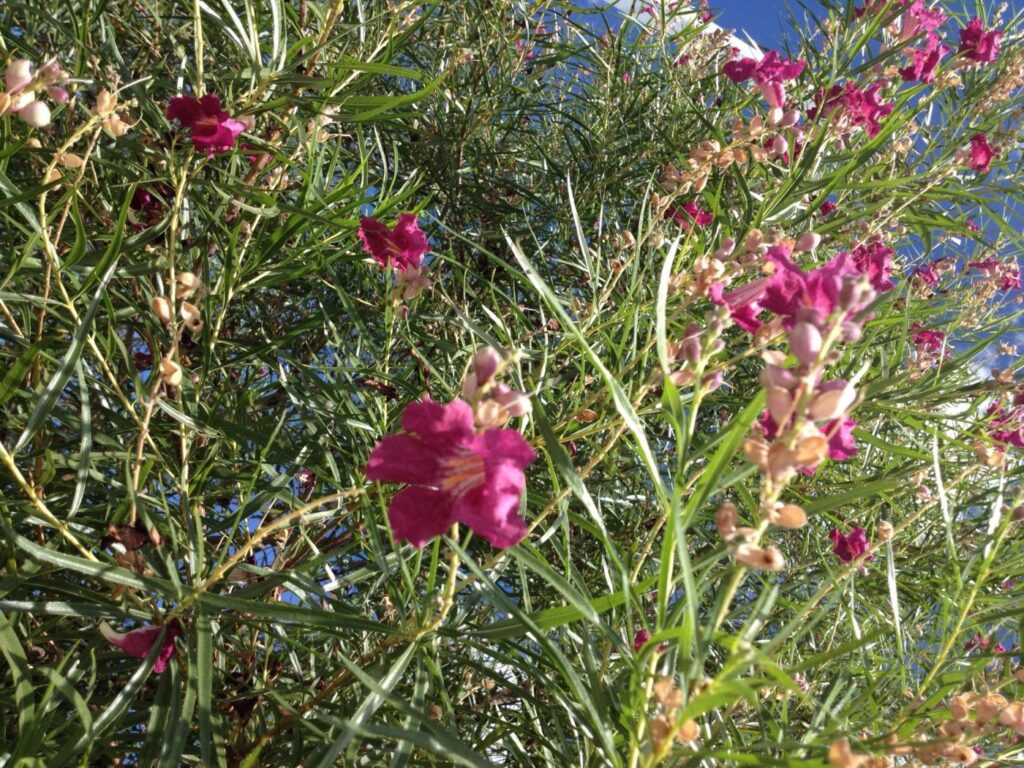
July is the ideal month to assess our need for trees. We may not even want to step out into the garden because of blistering heat, which could easily be mitigated by planting trees that cool the air, however.
It’s not only that trees provide shade but they literally cool the air through “transpiration cooling.” Transpiration has been referred to as botanical sweating. Just as the function of sweat is to cool us down on a hot day, transpiration cools down leaves and the air around them. Transpiration occurs when water passes from soil to roots all the way up to leaves. The final step in water’s transpiring ascent is when it exits leaves but hovers over them in gaseous vapor form. As heat passes through the vapor, there is a cooling effect. We experience this when we get out of a pool on a hot day and feel chilly because as the water on our skin turns to vapor, the hot air passing through the vapor cools the air.
This also explains why plants can wilt on a cool day if a strong wind is blowing. If the thin, cooling layer of water vapor on leaf surfaces is dispersed, the air surrounding leaves dries out. As fast as water is taken up through transpiration, it is immediately lost to the ambient dry air on a windy day. Eventually the leaves lose turgidity and wilt since the rate of transpiration or water ascent in the plant cannot keep up with the rate of foliar water loss.
Of course, the function of transpiration is not merely to keep leaves cool, but also to bring the hydrogen in water molecules up to leaves where photosynthesis, the process by which plants make their own food, takes place. Photosynthesis uses solar energy to split apart the hydrogen and oxygen elements of which water consists. Hydrogen atoms from water combine with carbon and oxygen atoms from carbon dioxide to make carbohydrate or sugar, the self-made food that sustains plants. When we apply fertilizers, we do not actually feed plants but rather provide minerals that make it easier for plants to engage in their photosynthetic, food-making process. Incidentally, the waste product of photosynthesis is the oxygen which we breathe (derived from the oxygen in water and half of the oxygen in carbon dioxide), which is discharged into the atmosphere to the benefit of all living creatures.
“Now is the Time for Trees” (Timber Press, 2022) is a beginner’s guide to selecting, planting, and caring for trees. It is authored by Dan Lambe of the Arbor Day Foundation and Lorene Edwards Forkner, a gardening columnist. Although the information provided is basic, it is definitive and bears the stamp of authenticity coming from the largest non-profit organization in the world dedicated to planting trees. Moreover, there is sure to be something here that is new to you, regardless of your experience with trees.
I learned that staking a tree when planting it is not desirable unless we are talking about “container-grown conifers or windy sites” since trees establish themselves more quickly when they are not staked. Furthermore, you do not want to stake tightly but leave slack in the straps looped between trunk and stakes, situated on opposite sides of the tree, so that “the tree should be able to sway in the wind without the rootball moving.”
I was keenly interested in finding out which trees the authors recommend for planting in our part of the country. Several oak trees are recommended including the cork oak (Quercus suber), a mature specimen of which is growing on the northeast corner of Van Nuys-Sherman Oaks Park on Hazeltine Avenue. Cork oak is noteworthy due to its spongy, hydrophobic bark.
The corks you may be popping tonight come from this tree, which is grown primarily in Portugal and Spain, but also in France, Italy, Morocco, Algeria and Tunisia. Harvesting the cork, or outer bark of these trees, is a special skill done entirely by hand. Improper harvesting procedures can kill a tree.
Normally, a cork oak is allowed to grow for 25 years before the virgin layer of cork is harvested. When harvesting is done correctly, the tree is not damaged and will regenerate another layer of cork in about 10 years. There are approximately 10 cork harvests during a tree’s productive life of 150 years, while a tree’s life span stretches to 250 years. Cork oak acorns are eaten for their nutty flavor in their native lands after being boiled like chestnuts.
Cork oak forests are in danger of disappearing, but not due to overharvesting or mismanagement. The problem is that corks made of plastic and silicone are less expensive than real cork and these stoppers are gaining wider acceptance, resulting in less demand for cork and subsequent neglect of cork oak forests. Still, nearly all premium wines continue to be stoppered with cork.
Cork oak itself is a highly drought tolerant shade tree and may be grown in desert conditions from the Antelope Valley to Palm Springs, the only caveat being that foliage may yellow in highly alkaline soil. To overcome alkalinity, apply gypsum to the soil around the tree on a regular basis, at least once a year. After two or three years in the ground, a well mulched cork oak will not require irrigation unless winter rains all but cease to fall.
In an email I recently received, Tamera Rooke asked this question: “How do you control the height of an avocado tree so that it does not get too high to pick the fruit?”
You can maintain an avocado or any other tree at a manageable height by keeping it pruned so that it does not exceed the height at which you are comfortable harvesting it.
If the tree has already grown so high that you would have to climb it to pick the fruit, Greg Alder (gregalder.com), the guru of avocado growers, suggests two options: you can either cut the tree down to a stump or selectively cut back two large branches each year until the tree assumes the desired harvesting height. In the first case, the stump remaining should be around five feet tall and will need to be painted (with a 50% interior white latex paint and 50% water solution) to prevent sunburn. In the second case, you will also have to paint newly exposed bark which will be more difficult higher up in the tree but, by cutting back only two branches each year, you will still be harvesting fruit as you bring your tree down to size. By the way, there is an avocado fruit picking pole with basket device that reaches up to fourteen feet so, with the help of a tall, sturdy ladder, you would be able to pick the fruit on a fairly tall tree without having to climb it.
A decision has been made to provide space for a “California native of the week” feature in this column. Many California natives, after being in the ground for a couple of years, require little if any summer water. They also attract wildlife and do not need fertilizer or pesticide applications to thrive. Certain California natives are also vanishing from their habitat and so we can take an active part in their preservation by bringing them into our gardens.
Related Articles
Master Gardener: What’s happening to my squash vines – and is this fruit safe to eat?
Succulents, bromeliads and more: What to do in the garden this week
Create a hummingbird habitat in your garden with colorful drought-tolerant California native plants
Gardening: Greywater growing, water-saving techniques and information on indoor plants
Asian jumping worms are a thing: Here’s how to keep them out of your garden
California native of the week: “Now is the Time for Trees” singles out desert willow (Chilopsis linearis) as a small California native tree, reaching 25 feet in height, that is appropriate for planting throughout the Southwest. Desert willow is so named because of its leaves’ slender stature that resembles that of a true willow’s leaves. Like the true willow, it also grows naturally along water courses even if, in the desert willow’s case, they are arroyos that go dry in summer months. Desert willow is extremely drought tolerant and handles blistering direct sun as well as cold down to zero degrees. In its habitat, it grows in proximity to two other native trees: palo verde (Parkinsonia species) and mesquite (Prosopis species). The desert willow has the distinction of being a monotypic genus, meaning it’s the only species belonging to its genus. (The pomegranate is another monotypic genus.) Desert willow’s trumpet flowers, which are mildly fragrant, attract hummingbirds and the tree serves as a nesting site for a variety of songbirds.
Please send garden questions, comments, and photos to [email protected].
